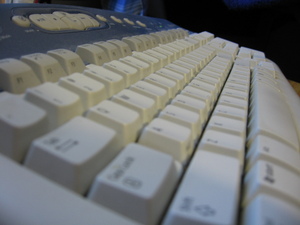In today’s cubicle-based world, solid typing skills are essential. It’s never any fun to be sitting there at your desk, slogging through a report while the girl across the isle is churning pages out at eighty words per minute. Still, there’s no point to pushing your fingers to the breaking point when you ultimately have to go back through what you’ve typed to fix the fifty typos you made. If this sounds like a problem you have, then please read on.
In typing, speed is no substitute for accuracy. The time you gain by going fast is negated if you need to go back and fix errors. Good typing skill includes the ability to be accurate as well as fast. In my opinion, it is easier to fix accuracy problems than it is to improve your speed, so that’s where we’ll start.
Tip # 1: Minimize Typos
Before you start to type, it is crucial that you have the proper hand placement on the keyboard. The index finger of your left hand should rest on the “F” key, and the index finger of your right hand should rest on the “J” key. These keys generally have a raised bump, so you can feel for the correct hand positioning while typing. The fingers of both hands should form a straight line across the center row of the keyboard. This means that your left pinky should rest on the “A” key and your right pinky on the “;” key. Both of your thumbs should rest lightly on the space bar. When typing, the backs of your hands should be parallel with the plane of the keyboard. This keeps your wrists from being either too high or too low (when this happens, your fingers might feel cramped or overly stretched when typing). One of the best things you can do is get one of the new ergonomic keyboards that has a padded wrist rest. This rest will automatically keep your hands in the correct position, as well as provide a comfortable support that will take the strain off your muscles.
This next piece of advice may sound counterintuitive at first, but it will really help you if you have an accuracy problem (those of you who don’t can skip this). If you make multiple typos per paragraph (or per sentence!) when typing, you need to do two things before you try and progress any farther. Slow down and look at the keyboard. Typos are usually caused by trying to go too fast, being unfamiliar about which keys are where, or a combination of both. Even if you think you know where the keys are, you might not be able to hit them all, especially when going fast. By looking down at the keyboard when you type and slowing down, you should be able to ensure that you don’t make any mistakes. While you’re doing this, it’s worth noting if you have a tendency to press keys with a non-optimal finger. For example, if you have a habit of pressing the “U” key with the middle finger of your right hand instead of with your index finger, you’re effectively bottle-necking your maximum speed. Now, you may feel like you’re moving in the wrong direction by taking this approach, buy trust me, you’re not. After a little while of typing like this, you should notice that you have a better feel for the locations of the keys. If you work at it, you’ll soon be able to type faster without making mistakes. Eventually, you’ll even be able to type without looking.
This brings me to the topic of maximizing speed. Once you’ve got your accuracy under control, you should focus all of your efforts on achieving the following tip.
Tip # 2: Type Without Looking
The ability to type without looking can double, triple, or even quadruple your typing speed, especially if you’re reading the words that you’re typing (there’s nothing worse than having to read a few words off the source that you’re copying and then have to look down at the keyboard to type them). Of course, the only way to be able to type without looking is to train your brain. Memorization of key position alone isn’t enough.
If you stare at the keyboard long enough, you could probably turn around and draw the key positions on a piece of paper. However, when you type, your fingers need to intuitively know in what direction to move in order to press the desired key. The only way to do this is practice. Type, type, and type some more. Force yourself to look up and keep typing. If you make a mistake, it’s OK to look down at the keyboard to get it right, but next time try the same word without looking. Eventually, you’ll get it.
To accelerate you on your way to typing without looking, it is helpful to memorize how to type a few common words. Take one of the words, close your eyes, and try to type it. If you get it wrong, go ahead and type it while looking, paying special attention to the “feel” of the word. Close your eyes and try it again. Below is a sample list of words that are good candidates for practicing on.
I, me, my, your, his, hers, she, he, him, her, it, of, and, the, to, from, then, that.
Tip # 3: Practice
The more typing you do, the faster you’ll get. It’s as simple as that. If your job only requires that you type a few E-mails a day, then you’re probably not getting enough practice. Try typing a page a day to start. If you’re not sure what to write, look in newspapers and magazines for articles that you can reproduce. Open up your favorite book and type the first page…or the first chapter, if you’re feeling ambitious. If you do this enough, you will improve.
Another option for practice is to use an online type-testing website. These websites have you type from an article or a story, and they evaluate your accuracy and speed. They’re a great way to get practice, and they give you the results of your ability. I prefer http://www.typingtest.com/ . This site uses a Java applet to feed you words to type, and to keep track of how you’re doing. It’s free to use, and it has a lot of links to other typing resources.
For The Ultimate Speed Demon
If you can bang out 80-90 words per minute, you might be hitting the limit of what is physically possible for your fingers on a standard QWERTY keyboard. That’s why people have taken to scientifically designing new keyboards to better optimize finger usage. One such keyboard is the XPeRT keyboard. On it, a few keys have been moved, so that your most dexterous fingers hit the letters that are used most often. There’s also an extra “E” key on the right-hand side, so you can type “E” with both hands (“E” is the most common letter). Check out http://www.xpertkeyboard.com/ for more information on the XPeRT keyboard.
The most popular alternative keyboard is the dvorak keyboard. The world’s fastest typing record was set on one of these keyboards. As with the XPeRT keyboard, the emphasis is on finger efficiency: with the dvorak, more words are typed by alternating letters between hands, which lets you go much faster. For more information about the dvorak, check out http://www.dvorak-keyboard.com/ .
In Summary
Basically, you can improve your typing ability by doing two things: train your fingers to know where all the keys are (type without looking) and maximize typing accuracy. Never try and type so fast that your accuracy goes down the toilet. Instead, strive to find that perfect balance between speed and accuracy. Work at it long enough, and you will type faster and smarter.




